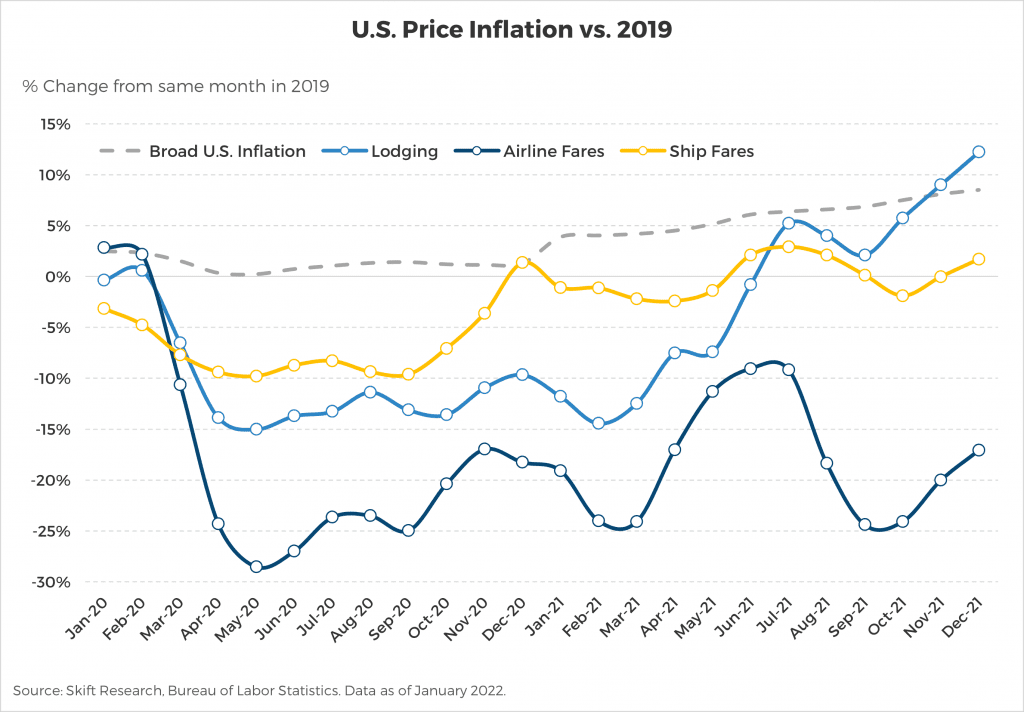Skift Take
Inflation can be a good thing for travel sectors able to play the rate game. But volume eventually has to catch up and play a part in the rebound. Otherwise, you run the risk of driving customers, no matter how desperate they are to travel, to just say no to high costs.
A little inflation could be good for the travel sector, industry sentiment went a few months ago.
But it is clear some segments are playing the pricing game better than others when it comes to accelerating their pandemic recovery.
Hotel rates in the U.S. are pacing above the national rate of inflation while cruise ships and airlines lag, according to Skift Research. Lodging prices at the end of last year were 12 percent higher than 2019 levels while ship fares were up 2 percent. Airline fares were 17 percent lower while U.S. inflation overall averaged 9 percent higher than 2019.
Pricing power and inflation, for industries that can get away with it, can lead to a faster recovery.
“It speaks a lot to the credit of the discipline that the hotel industry has had. It would seem they learned the lesson of 2001 and 2008, which is that discounting in a crisis can have long-term effects on consumer expectations and makes it really hard to regain pricing power,” said Seth Borko, a senior research analyst at Skift. “It also becomes a bit of a race to the bottom in terms of, as long as the hotel down the block is offering a promotion, you feel the pressure to discount as well.”

It took years for hotels to recover from the rate discounts offered after the Sept. 11 attacks and the Great Recession to shore up business. Hotels holding onto some level of pre-pandemic rates through the ongoing health crisis would accelerate the recovery for when occupancy came back, the thinking went. Discounting was unlikely to unearth new streams of demand when people were unsure whether it was safe to travel.
It was still a rocky start to the pandemic, as hotel pricing tumbled along with airlines and cruises during the spring of 2020. Hotels only began to outpace 2019 levels last summer, but the decision to command higher rates is proving to be a success for American hoteliers.
Luxury hotel revenue per available room — the industry’s key performance metric — was nearly 16 percent above 2019 levels for the last week of 2021, according to STR data. That’s largely due to pricing, as occupancy rates were 14 percent lower.
“It drives home that this was very much not a financial crisis. It was a safety crisis,” Borko said. “People had the money and the desire to travel but were afraid to go out and spend it. Now that things are re-opening, the hotels don’t need to discount to attract thrifty consumers. It’s just the opposite: Consumer demand is quite strong.”
A Selective Game
The inflation trend shows not every travel sector can deploy the hotel industry’s playbook.
Airlines took a bigger hit from travel restrictions than hotels, which could recalibrate easier and cater to drive-to and leisure travel trends that emerged during the pandemic. Even city hotels that typically relied on business travelers could market to the “stay-cation” segment of customers who lived nearby.
Many of the largest U.S. airlines like American, Delta, and United shifted away from normally lucrative business travel routes between major U.S. cities and instead focused on point-to-point leisure routes to markets like Florida. But leisure traffic for airlines typically translates to lower prices.
Delta’s domestic yields were down 9 percent during the fourth quarter compared to 2019 while unit revenue, a broader performance metric for airlines, was down 13 percent.
“The airlines have not been able to hold the line on pricing as well as hotels, but of course they were hit an order of magnitude harder than the hotels were,” Borko said.
Proceed With Caution
Inflation isn’t necessarily a silver bullet for hotels, however. In fact, it can be a double-edged sword.
Hotel executives over the last few quarters have said they can use rate inflation to compensate for wage increases needed to attract workers in the industry’s notorious labor shortage crisis.
But inflation in other sectors can drive potential business away. Higher prices at the gas pump can put a dent in road travel and soften demand for hotels in drive-to markets, the American Hotel & Lodging Association cautioned last fall.
The Omicron variant is likely another speed bump for the travel industry’s hotel recovery, but pricing trends seen so far during the crisis show U.S. hoteliers might be in the best position of the broader travel economy.
A Fitch Ratings survey reported this week in the Daily Lodging Report showed the highly contagious strain is likely to delay a full recovery for the global hotel industry, particularly in Southeast Asia and Europe.
American hotels still have a ways to go to get back to 2019 levels across all market segments, but the inflation game might end up maintaining the recovery momentum.
“Things are going to come back faster than prior recoveries here,” Hilton CEO Christopher Nassetta said on the company’s third quarter earnings call last October. “Typically, it’s a grind to build back occupancy, and rate lags significantly. Rate is leading the charge here.”
Have a confidential tip for Skift? Get in touch
Tags: coronavirus, coronavirus recovery, delta, hilton, hotels, inflation
Photo credit: U.S. hotel rate inflation in recent months helped the sector maintain its recovery momentum. William Warby / Wikimedia
